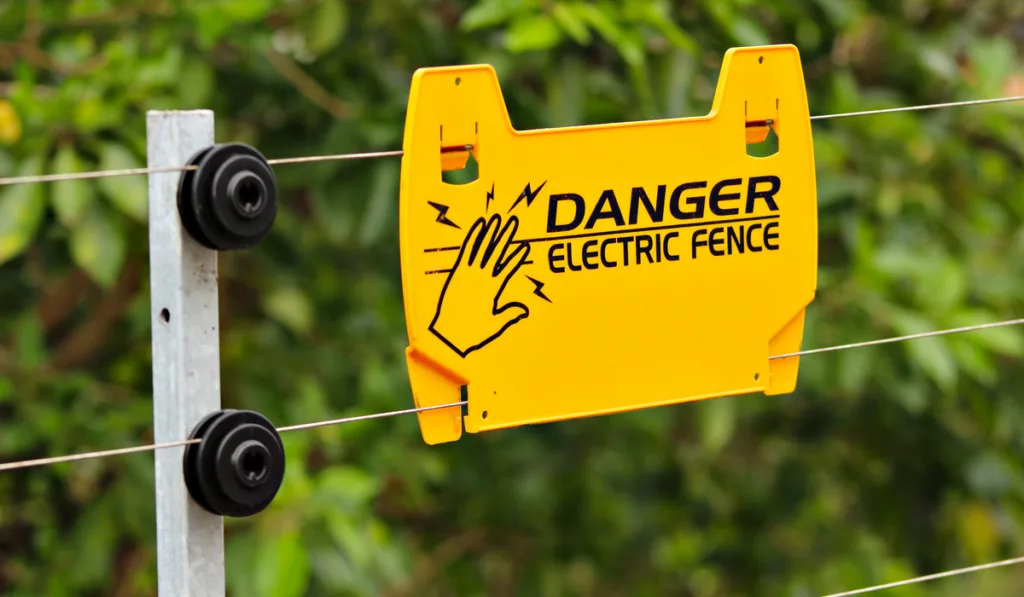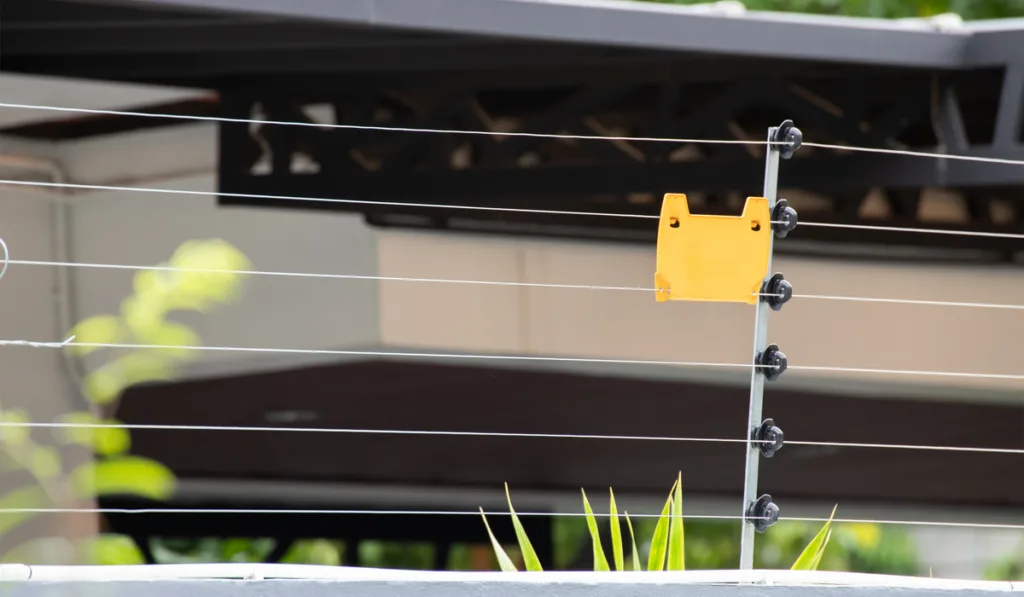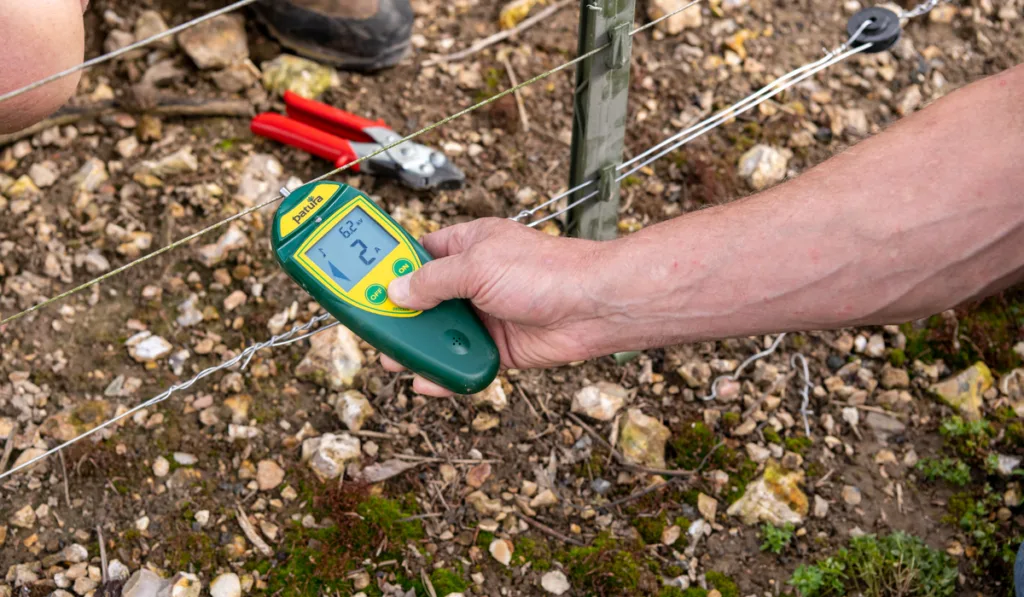An electric fence is used on many farms, homesteads, and even private houses and buildings to keep valuable possessions safe, sound, and secure. There are many different electric fencing types, but every electric fence’s basic requirements are the same.
Your electric fence may stop working because of broken parts or electrical problems. The following are the main reasons your electric fence may not be working.
- Breakages In The Fence
- Fault in the power supply
- Faulty lead out wire
- Fault in the ground system
- No voltage in the fence wires
If your electric fence is giving you some trouble, you can probably fix the problem by yourself without calling in the experts to fix it.

Being a farm or homeowner means that you should have at least a working basic knowledge of fixing things that have stopped working or have broken around your property. Troubleshooting and repairing an electric fence can be attempted by researching the fault first.
Table of Contents
5 Reasons Why My Electric Fence Isn’t Working
Your electric fence has stopped working, and you would like to troubleshoot the problem first to see if you can indeed repair it without calling in the experts. An electric fence comprises a fence charger, fence wire, ground wire, the ground system, and the lead-out wire.
We have compiled a shortlist of possible issues of what could have caused the electric fence to stop working,
There are only two main reasons why your electric fence isn’t working: no power to your fence wires or the power is not strong enough to charge the fence to be an effective deterrent
Perform the safety checks in the following order to ensure that everything is checked thoroughly. If no fault is found, move on to the next step. If a fault is found, follow the instructions on how to fix it.
Warning: always use insulated gloves and rubber boots to protect yourself while troubleshooting and fixing your electric fence.
1. Breakages In The Fence
Walk the length of the fence to check for any breakages that might have happened. Check that the connectors are wired correctly with no loose wires.
Ensure the wiring is not broken and does not have any debris like trees, grass, or leaves touching it. Check for damaged insulators and line breaks.
2. Fault In The Power Supply And Electric Charger (Energizer)
Check your power box to see if there is power leading to the box and then from the box to the fence charger. Use a voltmeter tester to measure the power output on the electric charger.
- If your system uses AC chargers, check that they are plugged into the primary power source and then check the main power source for low voltage output or no power at all.
- If your system uses DC or solar chargers, check the batteries before checking anything else to make sure they are fully charged. If the battery used as the power supply is not a sealed unit, monitor the battery cells’ electrolyte fluid level. Check the output and input terminals for corrosion.

If there is still no power to your electric fence, check the following for possible causes:
- Blown fuses
- Charger not plugged in
- Defective charger
- The energizer is the correct size for the fence size
3. Faulty Lead Out Wire
Turn off the power and disconnect both the lead wire and the ground system from the primary system. After turning the power back on, check the voltage output on the lead-out wire with a voltmeter. Reconnect the ground system.
4. Fault In The Ground System
Check the voltage of the ground system once it has been reconnected. If the voltage is defective, check the ground rods to see if any water has leaked into the ground system.
This procedure is hazardous and could require extra training if you are going to repair the fault yourself. If you are not experienced with electricity, it is best to consult an electrician for assistance.
5. No Voltage In The Fence Wires
Test each level of the fence for a power charge. Isolate and disconnect the other wire levels and only check one level at a time.
Check for short circuits on the fence wire by using an AM radio. If interference occurs with the radio signal, check the part of the fence that is closest to you for damages.
How To Fix Your Electric Fence
Now that you have checked all the possible problems with your electric fence, how do you fix all of the issues? Let’s start with the basics.
Equipment Needed To Fix Your Electric Fence
To repair your electric fence, you need to keep some basic supplies and equipment in your toolbox.
- A voltmeter, a pair of insulated gloves, and rubber boots.
- Replacement electrical parts – energizer, crimps, insulators, splicers, drive caps, ground rods.
- Replacement fence parts – wire, staples, spring gate, gate handles, fence flags, posts.
- Tools – Crimping tool, gripple tensioners, gripple torque tool, wire cutters, wire twister, wire bending tool, two-bolt clamps, jumper leads.

How Do I Fix My Faulty Electric Fence?
After troubleshooting, you should have found the problem with your electric fence. It now needs to be repaired so that the fence can work as it should. So how do you fix the issues? Before starting with any repairs, switch off the power to the electric fence.
1. How To Repair A Broken Fence
Repairing a broken fence should be easy enough if you have all the necessary equipment and replacement parts.
Remove anything that is broken and replace it with a new part. If the post has come loose in the ground or has been knocked over, replace the post and reinforce the hole.
Replacing the wire may be a bit more of a challenge as you will have to make sure that you replace the insulators in the correct position and that the wire is grounded. Follow all the instructions from the manufacturer on how to replace electric wire fencing.
Remove any debris that is touching the fence – cut back trees and grass as if they are touching the wire; they could impact the voltage.
2. How To Repair Faulty Electrical Equipment
Troubleshooting to find the fault should have led you to what needs to be repaired. Electrical problems could cover everything from the main power or the energizer to blown fuses or sparks due to wires on the fence touching.
Always wear insulated gloves before working on the electrical fault, even if you know that the power is switched off.
- If any of the insulators, hook-up wires, or jumpers are broken or faulty, replace them.
- If you have found fault with the ground rods, either replace them or install more rods if there is a problem with the voltage.
- If the problem lies with the voltage, you may need to replace the energizer.

Top Tips On How To Troubleshoot Electric Fence Problems
We have compiled a quick guide of what common electric fence problems are and the causes.
- Energizer dead. Check the primary power outage and ensure the energizer is switched on, check fuses, battery, cells, and corroded terminals.
- Energizer switched on but low voltmeter reading. Check for weak batteries, terminals corroded, energizer on low setting.
- Energizer switched on, but no voltmeter reading at the fence. Feedwire terminals corroded, ground-return wire disconnected or broken.
- Low voltmeter readings. Energizer on low setting or not strong enough for the length of the fence. Batteries weak, terminals corroded, inadequate ground system.
- No voltmeter reading at a location on the fence. Broken wire or dead short across wires. Disconnected jumper wire. Broken ground rods.
- Voltmeter reading higher on one wire than another wire. Broken fence, jumper, or ground wire. Faulty insulator. Broken ground rod.
Conclusion
Keeping your electric fence in running order does mean regular maintenance. If you cannot perform the required maintenance and repairs yourself, then be sure to call out a qualified maintenance man to get the job done.
Having an electric fence around your property is often necessary to keep your livestock under control if you live on a farm or a homestead.
The maintenance and upkeep of the electric fence can be pricey, but it is there to do a job and should be worth the expense in the long run.
Resources
- https://fencesupplyinc.com/troubleshooting-electric-fences/
- https://www.dirtyfootfarm.com/how-to-troubleshoot-electric-fence-problems/
- https://askinglot.com/why-is-my-electric-fence-not-working
- https://kencove.com/c/blog/article/repairing-your-electric-fence
